
UST’s new blog series, “COVID-19 Nonprofit Stories,” illustrates how nonprofits and their employees have been coping with the unexpected challenges of the Coronavirus. Each blog spotlights one organization and the personal hurdles and workforce strategies they have encountered throughout this pandemic.
Our next story comes from another dedicated UST member—DARTS. Located in Minneapolis, DARTS provides personalized professional services to the aging demographic in the local Dakota County. By providing transportation and home services to their aging community, DARTS helps participants to lead more independent and fulfilling lives. Their services include such things as light housework, outdoor chores, home repair, caregiving resources, transportation and more.
Q: In general, how has your nonprofit been impacted by COVID-19?
A: DARTS provides services to help older adults stay engaged in the community and live in home of their choice. COVID-19 has caused older adults to isolate themselves and their caregivers are either isolated from their loved one or unable to have respite from them. The need for our services grew and we had to rapidly adapt to be able to provide them safely.
Q: What was the most immediate impact your organization faced during the onset of COVID-19?
A: DARTS provides bus rides for groups of older adults, as well as individuals. The group rides stopped immediately on March 13. We took our bus capacity to help fill a need that older adults were not able or willing to go out to food shelves to get groceries by partnering with area food shelves to help deliver those food supports.
Q: What do you see as the long-term impact COVID-19 will have on your organization?
A: How we gather as older adults will be affected for months to come and so we are becoming more nimble with technology to supplement in-person meetings and group gatherings. COVID-19 will help those with means to rely more on technology and it will make the gap larger between those who have resources and those who do not.
Q: How have you addressed employee mental health and wellness during this time?
A: We added intentional time during team meetings to talk about COVID related stress and social justice issues. We hold regular optional coffee breaks so that people can still connect, leaders are proactively reaching out to their team, we are allowing flexibility for those who can to work from home and we got brightly colored DARTS shirts for employees – a cheerful reminder as to how important they are to our community.”
Keep an eye out for future renditions of “COVID-19 Nonprofit Stories,” as we continue to gather insight from the nonprofit sector. In the meantime, check out our COVID-19 Resource Center for more nonprofit-specific content—including unemployment insights, workforce trends, employee wellness tips, COVID-19 FAQs and more!

UST’s latest interactive webinar series, “UST Live,” brings the collective expertise of reputable nonprofit leaders to you—live—in virtual panel discussions.
In our second UST Live webinar, the panel discussed new (and successful) strategies nonprofit leaders have implemented since COVID-19 began, as well as common hurdles nonprofits are facing with future strategy development. Plus, get YOUR questions answered first-hand by your nonprofit peers—who have tremendous experience in strategic thinking and organizational sustainability best practices.
Watch now to discover:
Upcoming UST Live Webinars: In our final session for 2020—scheduled for November 19th—we’ll discuss innovative recruitment best practices that can help nonprofits attract quality job candidates during (and after) a pandemic.

Question: Can we reduce pay because of an economic slowdown due to COVID-19?
Answer: You can reduce an employee’s rate of pay based on business or economic slowdown, provided that this is not done retroactively. For instance, if you give employees notice that their pay will change on the 10th, and your payroll period runs from the 1st through the 15th, make sure that their next check still reflects the higher rate of pay for the first 9 days of the payroll period.
Nonexempt employees (those entitled to overtime) – A nonexempt employee’s new rate of pay must still meet the applicable federal, state, or local minimum wage. Employees must be given notice of the change to their rate of pay, and some states require advance notice.
Exempt employees (those not entitled to overtime) – An exempt employee’s new salary must still be at or above the federal or state minimum for exempt employees. The federal minimum salary is $684 per week. Several states have weekly minimums that are higher than that (California and New York, for instance, are in the $1,000 per week range). The minimum may not be prorated based on hours worked.
Exempt employee reclassification – If an exempt employee has so little work to do that it does not make sense to pay them the federal or state minimum (or you simply cannot afford to), they can be reclassified as nonexempt and be paid by the hour instead. This must not be done on a very short-term basis. Although there are no hard and fast rules about how long you can reclassify someone, it is recommended that you don’t change their classification unless you expect the slowdown to last for more than three weeks. Changing them back and forth frequently could cause you to lose their exemption retroactively and potentially owe years of overtime.
Employees with contracts or CBAs – If employees have employment contracts or are subject to collective-bargaining agreements (CBAs), you should consult with an attorney before making any changes to pay.
Q&A provided by ThinkHR, powering the UST HR Workplace for nonprofit HR teams. Have HR questions? Sign your nonprofit up for a free 30-day trial here.

To help nonprofits combat the most prevalent day-to-day workforce challenges caused by COVID-19, UST has launched a NEW interactive webinar series called “UST Live.” We’re collaborating with reputable nonprofit leaders & HR experts across the U.S. to bring their collective expertise to you—live—in hour-long, virtual panel discussions.
In our first UST Live webinar, the panel discussed the innovative employee management strategies that are being used for onboarding, training, employee development and employee engagement during these difficult times. Plus, the panel answered attendee’s questions related to HR best practices and employee relations management.
Watch now to discover:
Upcoming UST Live Webinars: This webinar series was designed to equip nonprofits with the strategies and resources they need to survive (and thrive) throughout this pandemic. Be sure to register for our next UST webinars—scheduled for October 15th and November 19th—where we’ll discuss how to develop a sustainable strategy for 2021 as well as innovative recruitment best practices.
The end of summer traditionally signals the start of a busy period for employers and HR professionals, as they update their policies to reflect regulatory changes, complete their HR initiatives for the year, and start their next-year planning. This fall promises to be especially active given the continuing pandemic and related HR challenges.
The start of the 2020-2021 school year has created confusion and disruption for both employers and their employees. As a result, ThinkHR, powering UST HR Workplace, has been fielding urgent questions about how to handle a variety of situations, including how online vs. in-person school impacts employee leave. Following are some of the most common questions received and their responses.
Q: If children and their parents can choose between in-person schooling or online schooling, can we deny leave to employees who choose online schooling?
A: We don’t know yet. EFMLA can be used when a child’s school or place of care is “closed,” such that the child cannot be there in person. This might suggest that if the option is available to attend in-person, that those choosing online school would not be eligible for leave. However, we expect that many school districts will need a certain percentage of students to take classes online to make in-person school possible at a sufficiently reduced capacity. In effect, these schools will be “closed” to a certain portion of the student body and it may or may not matter whether the parents chose the online option. We expect guidance from the Department of Labor soon that will answer this question definitively.
Q: If kids are going to school in-person two days a week and doing school from home three days a week, do we have to give a parent three days a week off or can we refuse intermittent leave?
A: If you’re in the Southern District of New York, you must grant intermittent EFMLA if that is what an employee needs and asks for. That district includes the counties of Bronx, Dutchess, New York, Orange, Putnam, Rockland, Sullivan, and Westchester.
In the rest of the country, the answer is not clear, but we certainly recommend providing intermittent leave (as does the Department of Labor). Employees with children are in desperate need of flexibility and understanding right now and refusing a request for intermittent leave may lead to low morale, low productivity, or the employee quitting.
Keep in mind that not all employees will want a full day off just because a child is doing school from home — many may request an hour or two in the morning and an hour or two in the afternoon. Being open to these kinds of requests should help you maximize productivity (as much as possible under tough circumstances) and reduce turnover.
Q: Can we set up childcare or tutoring in the workplace?
A: While it may be possible (and we applaud the creativity), you’d want to consult with an attorney or someone else in your state that is familiar with the kind of licensing and insurance that would be required to do this. Even if you were only allowing children in the workplace occasionally, and they remained under the control of their parent, you’d want to check with your general liability carrier to make sure that it would cover incidents that involved a visiting child.
Q: Can I deny leave to an employee who has high schoolers who should be able to take care of themselves during the day?
A: No. However, if the child or children are 15 or older, you should require that the employee provide a statement or affirmation that there are special circumstances that cause the older child to need their care. They do not need to provide any further information beyond that statement (such as what the special circumstances are). If you feel it necessary, you can remind all employees that it is fraudulent to take FFCRA leave if they are not unable to work as a result of the care they will be providing.
Q: Can we require proof that the school or place of care is closed?
A: No. You can and should (for IRS documentation) require the names and ages of the child or children being cared for and the name of the school, place of care, or caregiver that is closed or unavailable due to COVID-19. You should also require a signed statement that the employee is unable to work because they need to provide care for the child or children. Finally, if the child or children are 15 or older, the employee needs to indicate that there are special circumstance (but doesn’t need to explain them).
We don’t encourage independent sleuthing to verify what an employee tells you, but if you feel that’s necessary, be very careful of doing anything that could infringe on an employee’s right to privacy. Also be consistent in verifying this kind of information — if you are only fact-checking certain employees, you’ll open yourself up to complaints of unfair treatment.
Q: Can I ask an employee to look for different childcare if their usual provider is unavailable?
A: No. An employee is entitled to leave if the child’s usual care provider is unavailable due to COVID-19 — they are under no obligation to look for alternatives, and any attempt on your part to require that would be illegal interference with their right to leave.
Q: Can I deny leave if I think or know an employee is lying about the need to care for a child?
A: There is significant risk in denying a request for FFCRA leave if an employee has provided the appropriate documentation. That said, if you believe the request is fraudulent, you should have a discussion with the employee before granting or denying leave. If it turns out that they were submitting a fraudulent request — and you have sufficient evidence to support that — you can take disciplinary action if it seems appropriate. If, after discussion, you think their request is more likely than not legitimate, you should grant it.
Be careful of disciplining an employee who requests leave but doesn’t meet the necessary criteria. These leave entitlements can be confusing, and it would be unlawful retaliation to discipline an employee who was attempting to use their right to leave in good faith.
Q: If an employee’s stay-at-home spouse is sick with COVID-19 and unable to care for their children, can they take FFCRA leave to do so?
A: Yes, the children’s regular care provider (the stay-at-home spouse) is unavailable because of COVID-19, so the employee would be able to use either EPSL or EFMLA to provide care while their spouse is not able to do so.
Q: What if an employee won’t fill out the required FFCRA documentation?
A: The earliest an employer can require notice is after the first workday of FFCRA leave. (The regulations require employees to provide notice of their need for school closure leave as soon as practicable, but there are no consequences if the employee doesn’t do so.) If, after the first workday, the employee does not provide sufficient documentation to support their request for leave, they must be notified of the problem and given an opportunity to provide what is needed. If the employee still does not provide completed documentation after being given a reasonable opportunity to do so, then the employer is not required to provide FFCRA leave.
Q: Can we terminate an employee who is unable to work because they need to care for a child but have used up their leave under the FFCRA?
A: Assuming that no other leave laws apply, termination is an option. But you may want to instead consider offering the employee an unpaid personal leave of absence or revisiting whether a flexible or part-time work schedule would be better than losing the employee entirely. Recruiting, hiring, and training are all expensive undertakings, so if there’s a way to keep an employee around — even if they need some time off — that is likely better for your bottom line.
If you do decide to terminate an employee who is out of leave, make sure you can be consistent in that response going forward. If you are flexible with some employees while firing others, you will open yourself up to claims of discrimination.
Q: What if we find out after we’ve granted and paid for an employee’s leave that it was fraudulent? Do we make them pay us back or report them to the IRS?
A: There is not yet clear guidance about how to handle this situation, so we recommend calling your local Wage and Hour Division of the Department of Labor. They are generally very responsive and may be able to provide some guidance based on your situation.
The U.S. Department of Labor will continue to provide compliance assistance to employers and its employees on their responsibilities and rights under the FFCRA. The full 100-question Department of Labor FAQ can be found here.
This Q&A was provided by ThinkHR, powering the UST HR Workplace for nonprofit HR teams. Sign up for your FREE 60-day trialand test drive UST’s online HR platform! You’ll find HR-specific articles, templates and checklists as well as access to a plethora of tools including a live HR consultant, 300+ on-demand training courses and an extensive compliance library.

As we continue working from home—isolated from loved ones, juggling work/life balance and trying to make sense of this seemingly never-ending pandemic—stress levels are at an all-time high. So it’s more important than ever to ensure the well-being of your workforce.
The harmful side effects of long-term stress can lead to increased absenteeism, poor work quality and decreased morale. Taking the time to show you care about your employees’ mental health, by developing activities and resources that help alleviate stress, can create a sustainable, positive workplace.
Without effective mental health resources in place, it could cost your organization its best employees. Uncover 7 Tips to Keep Your Nonprofit Employees Mentally Sound to help foster an engaged workforce during these uncertain times.
Would you like access to more HR-specific articles, templates and checklists? Sign up for a FREE 60-Day UST HR Workplace Trial today! (Use priority code “2020HR-Content” to expedite your request).

The Coronavirus pandemic has pushed the economy into a sudden and deep recession, impacting local businesses as well as a number of large corporations. But the effects of this pandemic on the nonprofit organization has been even more substantial and unfortunately, gone unnoticed. Many citizens rely on the services nonprofits provide such as, social services, medical care and spiritual community. Tens of thousands of nonprofits are likely to close without the support of some kind of rescue package to help keep their doors open. The nonprofit sector is the nation’s third-largest private employer, with 1.3 million nonprofits employing nearly 12.5 million people—about 10 percent of the total number of people working in the private sector.
According to the John Hopkins University 2020 Nonprofit Unemployment Report, more than 1.6 million nonprofit jobs have been lost between March and May of 2020. Private education nonprofits lost an estimated 323,201 jobs, while health care lost an estimated 574,530. As we know, nonprofits come in many shapes and sizes, ranging from large organizations, like city hospitals to small mom and pop thrift shops that help support local charities. No matter the size, nonprofits have been severely impacted by the pandemic in more ways than one. Many nonprofits are unable to perform normal day-to-days tasks due to the number of shutdowns and social distancing requirements. For food pantries and free clinics, the economic disruption has caused an increase in clients in need of these services. While many think of nonprofits as running predominately on donations, roughly half of their revenue come from billing for services, a third from government contracts and grants, and only about 9 percent from individual donations.
While some foundations and charitable-giving funds have seen an increase in their donations, other nonprofits have not had the same luck due to relying on revenue-generating activities and fundraising. Making it not only difficult to keep people on the payroll but also impacting long-term viability of their organization.
Many nonprofits were eligible for federal pandemic aid under the Paycheck Protection Program, which extended potentially forgivable loans to small employers to keep workers on the payroll. But qualifying for such aid can be difficult. Give Kids the World received $1.75 million, however, organizations like the Y.M.C.A. of Metropolitan Chicago were left out because they had more than 500 employees.
The nonprofit sector has more of an impact on the overall economy than many realize—offering crucial contributions to the country’s health, education, social service, and cultural activities. Nonprofits not only make up the country’s third largest workforce but also generate the third largest payroll of any national industry while making important contributions to the tax revenue of the country’s national, state, and local governments. The devastation of this pandemic has put many individuals out of work while closing the doors of many other beloved nonprofits—putting pressure on the vital services these organizations offer their communities.
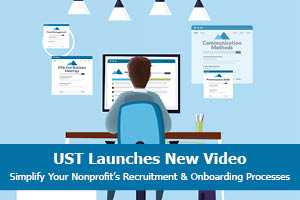
For over three decades, UST has been providing nonprofits with HR solutions that help manage day-to-day workforce issues, ensure compliance, and maximize employee bandwidth. By offering essential tools such as the job description builder, customizable online employee training tracks, and onboarding checklist, UST helps nonprofits maximize productivity and increase employee engagement.
As part of UST’s ongoing efforts to strengthen and educate 501(c)(3) organizations, we’re excited to announce the recent launch of our newest short video—designed to provide a snapshot of UST’s cloud-based HR platform. About a minute long, this video highlights tools that allow nonprofit employers to navigate the many complex realms of human resource management with ease—including recruitment and employee training.
Check out our newest video today to discover how our virtual HR services can help streamline your nonprofit’s HR processes and simplify day-to-day tasks—so you can focus more time on what matters most: keeping your mission-driven initiatives moving forward.
Test drive UST’s online HR platform today and explore some of these essential HR checklists and training solutions for yourself! Sign up for your FREE 60-Day HR Trial here!
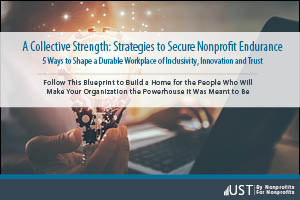
UST releases a new eBook, focused on positive brand perception in today’s increasingly competitive job market.
Founded by nonprofits, for nonprofits, UST publishes an eBook that discusses the importance of ensuring you have a solid brand reputation and why. This insightful eBook uncovers strategies that nonprofit employers can utilize to attract employees that fit their organization’s culture, mission, and values—and keep them.
Available now for download, UST’s eBook explores 5 key strategies that can help strengthen your organization’s culture through inclusivity, innovation and trust.
You’ll also discover:
Don’t miss your opportunity to download your complimentary copy of “A Collective Strength: Strategies to Secure Nonprofit Endurance” to discover how to attract better talent and promote a diverse and inclusive workplace.
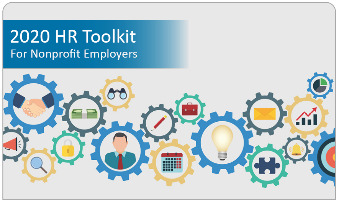
Here at UST we’ve put together our Top 10 Guides for 2020 Nonprofit Human Resource management. And for a limited time, we’re giving them away for FREE.
Since 1983, UST has provided nonprofits with the latest HR resources in an effort to help organizations stay compliant, maximize employee bandwidth and reduce overhead costs. This toolkit includes updated 2020 state and local minimum wage data and recordkeeping requirements, as well as a variety of checklists to ensure compliance. Plus, you can discover facts surrounding COVID-19 laws and the latest workplace protocol.
Still have questions? You can get a free 60-day trial of UST HR Workplace, powered by ThinkHR. This cloud-based HR platform offers a live expert hotline, 300+ online training and compliance courses, compensation tools, employee handbook builders and employee classification step-by-step guides. Set up your ThinkHR Trial today!

Question: Some of our employees have said they don’t feel safe returning to work. Can we just permanently replace them?
Answer: We recommend extreme caution when deciding to replace an employee who refuses to work because of concerns about COVID-19. Generally, employees do not have a right to refuse to work based only on a generalized fear of becoming ill if their fear is not based on objective evidence of possible exposure. However, under the current circumstances, where COVID-19 continues to be a threat across the country, we think it would be difficult to show that employees have no reason to fear coming in to work, particularly but not exclusively in a location with a shelter-in-place rule. Returning employees may also have certain rights under state and federal law. Here are few things to keep in mind:
Check state and local law to see if additional protections may apply.
Instead of replacing employees who express fear at this time, we recommend that you consider methods to encourage employees to come to work and to help put their minds at ease. Consider emphasizing all of the safety methods you have put in place (such as scheduled handwashing, frequent disinfection of surfaces, social distancing rules, reduced customer capacity, staggered shifts, or more extreme measures if warranted by your industry). We recommend relying on the Centers for Disease Control and Prevention (CDC) and local health department guidance for establishing safe working conditions at this time. You might also consider offering premium pay (a.k.a. hazard pay) or additional paid time off for use in the future to employees who must come to work.
Q&A provided by ThinkHR, powering the UST HR Workplace for nonprofit HR teams. Have HR questions? Sign your nonprofit up for a free 60-day trial today.

As nonprofit organizations prepare to return to business as usual, there are quite a few new safety protocols being put in place to ensure that employees return to a safe work environment. The Center for Disease Control – CDC continues to release updated guidelines for employers to help prevent and slow the spread of COVID-19 in the workplace. When making decisions around business operations, two main components should be factored in: (1) the level of disease transmission in your community and (2) how prepared your business is to protect both your employees and customers.
Employers are encouraged to coordinate with their state and local health officials to acquire timely and accurate information to provide updates to employees as needed. If your nonprofit’s business operations were put on hold, or are gearing up for workforce re-entry, this is an opportunity to update your COVID-19 preparedness, response and control plans.
When making the appropriate updates to your organization’s COVID-19 plans, the following items should be included:
Be sure to take the time to communicate with your employees of any changes and ask for their input—their questions and concerns can ensure all your bases are covered when creating the COVID-19 plan for your organization. Educating our employees on the severity of taking the necessary precautions to keep themselves and others safe is vital. To protect themselves while at work and at home, new policies and procedures related to illness, cleaning and disinfecting should be followed.
To ensure a safe workplace environment, employers should advise their employees of the following:
While there is much more to learn about the severity and characteristics of this virus, as a nonprofit employer, you can do your part to follow important guidelines to create a safe and healthy working environment for your dedicated employees.
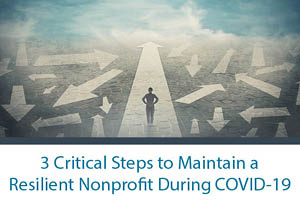
Are you still trying to figure out how to navigate the uncertainty of COVID-19 and its impact on your nonprofit and its employees? When you download UST’s new employer guide, 3 Critical Steps to Maintain a Resilient Nonprofit During COVID-19, you’ll discover helpful tips on maintaining your nonprofits operations during the current pandemic and beyond.
This short employer guide shares valuable insights and key strategies for securing your brand during times of crisis, including:
This guide will not only enable you to stay on top of strategy development, but also equip you with the tools you need to help your employees feel safe. Download your FREE copy today!

Nonprofit employers have faced unimaginable challenges in the wake of the COVID-19 pandemic. Now, as states start permitting businesses to reopen, nonprofits across the country are trying to figure out what that looks like for them, their employees and the communities they serve.
This informative webinar recording provides helpful tips for preparing to welcome employees back to the office while maintaining compliance with state and federal regulations related to the Coronavirus. Watch now to discover:
For additional COVID-19 employer resources and FAQs, please visit our COVID-19 Resource Center today!

UST is deeply saddened by the series of disturbing and tragic events that have taken place over the last few weeks related to the violence and injustice toward the Black community—including George Floyd, Breonna Taylor, Ahmaud Arbery, and countless others. The resulting protests have created a long overdue flashpoint for awareness, action, and change.
UST has supported the nonprofit community for over 35 years and we are proud of the impact that each of our members have in their communities. We know that communities that have nonprofit organizations established within experience less crime, such as murder, violent crime and crimes against property. Sharkey’s work also affirms some of the tenets of community policing: that neighborhoods are vital to policing themselves, and that they can address the complex roots of violence in ways that fall beyond traditional police work. Whether it is taking back the public parks, establishing mentorship programs for youth or implementing job training and employment opportunities, these all make a difference. But. That. Is. Not. Enough.
UST does not do this work directly but we support the organizations who do in their efforts, their ideals and their fight for more social justice and equity in communities across the nation. We are fortunate to have a strong board of Trustees who are all working in their own spaces for change. We think our current Board Chair, Karen Beavor, CEO of the Georgia Center for Nonprofits has expressed our sentiments exceptionally well. View her complete message here.
UST will continue to support the work our nonprofit members do to address these issues; we will listen, and will actively look for ways to be part of the change that is so desperately needed.

Question: Can we screen employees returning to work for COVID-19?
Answer: Yes. Generally, inquiries about an employee’s health or a medical exam (like a temperature check) would not be allowed, but the Equal Employment Opportunity Commission (EEOC) has stated that screening employees for symptoms of COVID-19 is allowed since it is a direct threat to others in the workplace. Because of that, you may inquire about symptoms related to the virus, require self-reporting by employees, and take employees’ temperatures.
Known symptoms of COVID-19 include fever, cough, chills, shortness of breath or difficulty breathing, muscle pain, headache, sore throat, and sudden loss of taste or smell. As the medical community learns more about COVID-19, additional symptoms could be added to this list. Employers can check this page for currently recognized symptoms.
If you decide to do screenings, make sure you screen all employees; otherwise you may find yourself in the middle of a discrimination claim. And remember that all information about employees’ health — including a lack of symptoms or temperature — must be kept confidential.
Q&A provided by ThinkHR, powering the UST HR Workplace for nonprofit HR teams. Have HR questions? Sign your nonprofit up for a free 60-day trial today.

COVID-19 continues to dominate headlines—in more ways than anticipated. While cybercriminals are always looking for ways to scam victims, pandemics provide additional opportunities for fraud. As people are spending more time than ever on their smart phones, iPads, and computers for work, shopping and entertainment, cybercriminals are ramping up their activities and getting more creative with their methods of hacking unsuspecting victims.
According to the Federal Trade Commission (FTC), scammers are using COVID-19 to further target consumers and businesses alike. They’re setting up websites, contacting people by phone and email, and posting dishonest information on social media platforms. Being aware of the different types of scams out there is the first step in protecting yourself, your business and your employees. Knowing how to handle those scams can save you a great deal of headache down the road.
The following are some examples of scams linked just to COVID-19:
Take the following precautionary measures to protect your organization and its employees from known and emerging scams:
With so many people working remote, hackers are looking for companies to drop their defenses, making it easier to infiltrate networks. When people are aware of what scams are out there, they are much less likely to fall for them. Talk about the risks with your management team, create a simplified outline of what to look for, and how to respond and relay to your entire staff.

On March 11, 2020, the World Health Organization (WHO) declared the COVID-19 coronarvirus outbreak a pandemic leaving nonprofit employers across the states scrambling to understand the impact on their business. Now that orders are being lifted and we prepare to re-enter the workplace it’s important to understand the do’s and don’ts of implementing new COVID-19 procedures within your organization.
Do you know whether employers are permitted to take employees’ temperatures and ask about symptoms? Or if employers should allow employees to work at the office if they have been exposed to COVID-19, but are not showing any symptoms?
Since it’s often difficult to differentiate the credible information from the bogus, UST has compiled a COVID-19 Fact vs. Fiction handout for nonprofit leaders. Uncover the answers by downloading the COVID-19 Fact vs. Fiction Employer Handoutand discover other key COVID-19 facts as well as common misconceptions.
Ensure that Your Nonprofit Stays Compliant! Get a FREE 60-Day Trial of UST HR Workplace, powered by ThinkHR—a cloud-based platform that provides access to a live HR hotline, COVID-19 policy updates, thousands of documents and more. Request your free trial today at www.chooseust.org/HR-trial.

While we continue to adjust to this new “normal” of working remotely—with little to no face-to-face interaction—the COVID-19 pandemic has taken a major toll on nonprofit employees and their mental health.
This informative webinar provides helpful tips on how nonprofit leaders can help keep employees productive and engaged in day-to-day work activities. Watch now to learn key strategies that include:
For more access to nonprofit specific how-to guides, checklists and resources? Sign up for UST’s monthly eNews today!
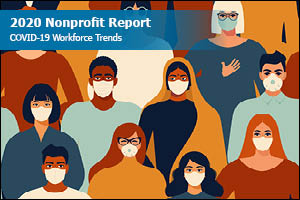
In a recent nonprofit survey, UST uncovered how COVID-19 has affected 501(c)(3) nonprofit organizations, their employees and operational strategies.
With nearly 800 survey respondents—representing a wide variety of nonprofits from across the U.S.—this report highlights critical COVID-19 information, including:
This report will provide valuable insight on how nonprofit organizations are coping with the unprecedented challenges during this pandemic. Download your complimentary copy today.

Question: What’s the difference between a furlough and a layoff?
Answer: First, you should note that the language used when sending employees home for a period of time is less important than communicating your actual intent. Since temporary layoffs and furloughs are only used regularly in certain industries (usually seasonal), you should not assume that employees will know what they mean. Be sure to communicate your plans for the future, even if they feel quite uncertain or are only short-term.
Furlough
A furlough continues employment but reduces scheduled hours or requires a period of unpaid leave. The thought process is that having all employees incur a bit of hardship is better than some losing their jobs completely. For example, a company may reduce hours to 20 per week for a period of time as a cost-saving measure, or they may place everyone on a two-week unpaid leave. This is typically not considered termination; however, you may still need to provide certain notices to employees about the change in the relationship, and they would likely still be eligible for unemployment.
If the entire company won’t be furloughed, but only certain employees, it is important to be able to show that staff selection is not being done for a discriminatory reason. You’ll want to document the nondiscriminatory business reasons that support the decision to furlough certain employees and not others, such as those that perform essential services.
Layoff
A layoff involves terminating employment during a period when no work is available. This may be temporary or permanent. If you close down completely, but you intend to reopen in the relatively near future or have an expected reopening date — at which time you will rehire an employee, or all employees — this would be considered a temporary layoff. Temporary layoffs are appropriate for relatively short-term slowdowns or closures. A layoff is generally considered permanent if there are no plans to rehire the employee or employees because the slowdown or closure is expected to be lengthy or permanent.
Pay for exempt employees (those not entitled to overtime)
Exempt employees do not have to be paid if they do no work at all for an entire workweek. However, if work is not available for a partial week for an exempt employee, they must be paid their full salary for that week, regardless of the fact that they have done less work. If the point is to save money (and it usually is), it’s best to ensure that the layoff covers the company’s established seven-day workweek for exempt employees. Make it very clear to exempt employees that they should do absolutely no work during any week you’re shut down. If exempt employees do any work during that time, they will need to be paid their normal weekly salary.
Pay for nonexempt employees (those entitled to overtime)
Nonexempt employees only need to be paid for actual hours worked, so single day or partial-week furloughs can be applied to them without worrying about pay implications. We recommend that you engage in open communication with the affected employees before and during the furlough or temporary layoff period.
Q&A provided by ThinkHR, powering the UST HR Workplace for nonprofit HR teams. Have HR questions? Sign your nonprofit up for a free 30-day trial today.
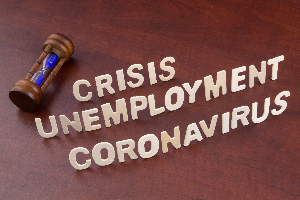
Nonprofits are facing unprecedented challenges navigating COVID-19 and its impact on day-to-day operations. Our recent webinar was designed to provide some valuable insight into the latest unemployment legislation and its impact on your organization and its employees.
This informative webinar recording discusses how COVID-19 is impacting nonprofits nationwide, what alternatives there are to layoffs and/or workforce reductions and more. Watch now to discover:
For additional COVID-19 employer resources and FAQs, please visit our COVID-19 Resource Center today!

It’s natural to feel stressed or anxious when presented with unprecedented circumstances. The coronavirus or COVID-19 continues to present new and unique challenges that evolve every day. Nonprofit employers are navigating unchartered waters and their employees are along for the ride. Many are working from home for the first time, isolated from co-workers, friends and family while also home-schooling their children and or taking care of elderly family members. This disruption in our daily routines has caused added anxiety, stress and strain—physically, mentally and financially. All of this combined makes it more important than ever to find new ways to interact and communicate with others while also taking care of our mental health and physical well-being.
You can’t avoid stress completely but too much stress over long periods of time can be harmful to your health—ranging from headaches, decreased energy, irritability, body aches and pains, irregular sleep or insomnia, difficulty concentrating or worse, can contribute to serious health problems such as high blood pressure, heart disease and mental health disorders. The good news is you can get ahead of stress by recognizing how you feel and practicing ways to find calmness.
Below are some ways to manage stress and anxiety through positive self-care and healthy social connections:
Be selective about how you consume COVID-19 information – while it’s good to be informed and aware of what’s going on around the world and in your community while we combat this virus, ensure you follow credible sources such as the Centers for Disease Control (CDC) and the World Health Organization (WHO) and limit how much time you spend absorbing that information.
Set boundaries on your work schedule – it’s easy to keep working when you have no reason to get up and leave the office but it’s important that you set a schedule with healthy boundaries and stick to it.
Maintain a routine – having some semblance of structure and consistency from your pre-Coronavirus life will help to keep a sense of control and normalcy while also making it a little easier to readjust to the outside world when it’s time to go back to work.
Limit your time online – set a timer, focus on positive things while you are online and divide your time between the different sites you like to browse. You can even install a website blocker to help temporarily force you off certain websites.
Stay connected – our greatest resource for alleviating stress is still connecting with our loved ones. Don’t just pick up the phone, use Skype, FaceTime or Google Hangouts to get some face to face time.
Leverage Mindfulness-Based Stress Reduction – the practice of meditation can help relieve anxiety, boost your mood, improve sleep and promote mental and emotional health—the benefits are endless and you can do it anytime, anywhere.
Stay active – this isn’t just good for your physical health but also for your mental health so don’t let this time at home go to waste. It’s important to keep moving, whether it’s strenuous exercise, Yoga or even just light stretching. You can find an entire universe of free classes online right now with many instructors live-streaming classes from home.
Get outdoors – fresh air goes a long way in easing the feelings brought on by stress and anxiety. Take a long walk around your neighborhood or go for a bike ride and enjoy some new scenery—all while maintaining physical distance from others of course.
Embrace a hobby – partake in something you really enjoy doing just for the fun of doing it. Something that requires attention and physical movement like embroidery, scrap-booking, painting or sewing to name a few.
Learn a new skill – knowledge is power as the saying goes. There are an unlimited number of online classes you can partake at no or minimal cost that range from bread making and drawing to crochet and learning a new language. Skillshare and Udemy are great resources.
Take an adventure through a book – start a mini book club and invite your friends to participate via video so everyone can share their thoughts and interact as a group.
Get in the kitchen – if you enjoy cooking or baking, there’s no better time than now to try out some of those recipes you’ve been waiting to experiment with.
Do some Spring cleaning – it is Spring after all. Organize those drawers that have been begging for order, clean out your closets, and donate what you no longer need or use, or work on getting your filing cabinet in order.
Watch feel-good movies – musicals are a great way to lift your spirits if you’re into that or distract your mind with an old black and white classic.
Count your blessings – take a few moments to focus on all that you have. Be thoughtful and sincere about who and what you appreciate in your life and let them know.
Find an online support group – there are a plethora of websites out there that offer virtual or phone options for group or individual support as well as live chat rooms. Having others to talk to that share your same concerns can help alleviate the anxiety brought on by COVID-19.
As we protect ourselves against potential exposure to the coronavirus, keep in mind that social distancing does not mean social isolation and remember that you’re not alone. Look after yourself, get enough sleep, eat well, and reach out to your support network. Engage in activities that benefit your well-being, bring you happiness, and distract you from existing challenges. Set your sights on long-avoided tasks or projects and try something new. The above mentioned tips about self-care are meant to help you thrive in mind, body, and spirit. Coping with stress in positive ways will make you happier, healthier, and stronger.

While in the midst of a global emergency, the current COVID-19 pandemic, nonprofits are challenged with how to successfully continue managing their mission-driven brand. Going the extra mile to prepare your organization for handling such a feat, will help you and your team better tackle any challenges that arise.
This is an opportunity to align your messaging with what your community needs and/or might be seeking during this time. A crisis is temporary and taking the time to show your nonprofit in a new light by providing specific messaging can instill a sense of trust and value that will be long lasting. It’s important to maintain vigilance in protecting your staff and being an example of a model citizen by not participating in unsafe behavior. Above all else, nonprofits must remain diligent of their brand and visible by its community to ensure they come out of this stronger than before. Here are few objectives for your nonprofit to keep in mind:
When it comes to collaboration in times of a crisis, you’ll have to get creative. These strategies shouldn’t complicate your current workflow but rather benefit your organization—having these tools in place will be very beneficial when a crisis is upon us. Taking your staff into consideration and how they’ll continue to operate is vital to prevent interruptions with current business tasks. For example, if your employees are required to work from home for any duration of time, what logistics and tools should you have in place to ensure everything runs smoothly? Tools such as, GoToMeeting and Slack allow your team to stay connected with one another while still being able to conduct important meetings and to ensure your mission continues to move forward. With the access to technology, it can make it easy to work from anywhere.
In times of a global emergency, having a plan in place to manage your organization, brand and team through the crisis is just as important as the ability to remain flexible and creative.

Here at UST, we understand the importance for nonprofit leaders to remain informed and prepared as the recent outbreak of the Coronavirus continues to impact the communities you serve. Nonprofit organizations nationwide have had to react quickly to a rapidly evolving crisis and change their standard business practices to maintain critical operations.
Like so many of you, we have transitioned to remote work and are continuously gathering resources to stay on top of the quickly evolving legislative developments designed to mitigate the economic fallout triggered by the public health response. We’ve also been in close contact with our strategic partners nationwide to ensure that the unique needs of nonprofit employers are being prioritized by our elected representatives during this time.
In an effort to help keep nonprofits abreast of evolving information, we’ve created a dedicated COVID Resources Webpage on our website, which we’ll continuously update, provides:
We’ll continuously be updating this page so please check back regularly and bookmark the page above for easy reference. UST has been supporting nonprofit employers for over 35 years and understand the value of being informed during times of uncertainty and challenge. Please know our thoughts are with all who have been impacted by the recent outbreak of COVID-19 and we’re here to answer any questions you may have.

With the rapid spread of the Coronavirus, also known as COVID-19, we have taken appropriate precautions here at UST to do our part of social distancing by working remotely as we know many of you have as well. Here in our local communities we see fear and panic everywhere—empty shelves at the grocery store, people standing in line for hours to get paper products, schools scrambling to move to a virtual method of teaching, large department stores closing their doors and citizens pushing for cities to lockdown.
New details pour in every day and our inboxes are flooded with shared information from our partners and members across the states. Yesterday, there was an article shared by our partner, ThinkHR, “When Business Threats are Contagious: 10 Answers for Employers Navigating the Coronavirus” that shares questions they have been receiving from HR professionals across the country. They range from how to handle employees refusing to come to work, creating a telecommuting policy and the appropriateness of asking about symptoms. The answers come from their certified HR advisors and is a benefit of our UST HR Workplace product. If you are an HR professional in a business still considering how to navigate these challenging times, you may find some answers here.
Q&A provided by ThinkHR, powering the UST HR Workplace for nonprofit HR teams. Have HR questions? Sign your nonprofit up for a free 30-day trial today.

Capacity building is an investment in the effectiveness and future sustainability of your nonprofit organization–does your nonprofit have the ability to deliver according to its mission effectively now and is it prepared to do so in the future?
Some examples of capacity building projects may include, identifying a new communications strategy, a different approach to volunteer recruitment, ensuring thoughtful leadership succession, and bringing your nonprofit up to speed with the latest technology. Each of these projects can help build a nonprofit’s capacity to deliver its mission. When capacity building is successful, it will strengthen your nonprofit’s ability to fulfill its mission and help to enhance the positive impact your nonprofit has on the lives and communities it serves.
Capacity building can be developed across multiple levels—individual (micro), organization (meso) or sector/network (macro) and often times, these levels are developed at the same time. For instance, at the individual micro level, programs may enhance people’s knowledge and behavior in ways that can strengthen culture, management practices and connections to other organizations (meso level) and then encourage overall participation in collective action networks (macro level). It can be helpful to look at capacity building from the perspective of who (e.g., people, organizations, networks), what (e.g., knowledge, skills, processes), and how (e.g., training, peer learning, technical assistance).
From a time management and impact on bandwidth perspective, capacity building initiatives fall into three categories; short-term planning and training, longer-term organizational effectiveness initiatives and sector-strengthening programs that encourage the exchange of information. Capacity building produces multiple benefits simultaneously, such as learning and peer interaction.
When looking at capacity building and nonprofit work in general, it can be difficult to not view capacity building, especially multiple forms of capital, as an additional task. However, when executing the program mindfully, building capital can occur through service delivery. A multiple-capitals approach to program design can help produce mission fulfillment and increase overall effectiveness of the organization. A multiple-capitals framework integrates planning, service delivery, evaluating, and reporting—in return, offering a smoother, integration of organizational activities and stakeholder accountability.
Capacity building is an important infrastructure that supports and shapes nonprofits success in helping the communities that serve. Capacity building enables nonprofit organizations and their leaders to develop competencies and skills that can make them more effective and sustainable, while increasing the potential for nonprofits to enrich lives and solve society’s most intractable problems.

Question: Is having different parental leave programs for women and men discriminatory?
Answer: Yes. Parental leave must be provided to similarly situated men and women on the same terms. For example, if an employer extends leave to new mothers beyond the period of disability from childbirth (for instance, to provide the mothers time to bond with and/or care for the baby), the employer cannot lawfully fail to provide an equivalent amount of leave to new fathers for the same purpose.
According to Title VII of the Civil Rights Act of 1964, an employer may not discriminate against an employee on the basis of pregnancy, childbirth, or related medical conditions; and women affected by pregnancy, childbirth, or related medical conditions must be treated the same as other persons not so affected but similar in their ability or inability to work. It is important to note that for purposes of determining these Title VII requirements, employers should carefully distinguish between leave related to any physical limitations imposed by pregnancy or childbirth and leave for purposes of bonding with a child and/or providing care for a child (parental leave). Leave related to pregnancy, childbirth, or related medical conditions can be limited to women affected by those conditions.
The Equal Employment Opportunity Commission (EEOC) provides the following examples of nondiscriminatory versus discriminatory leave policies as applied to men and women:
Q&A provided by ThinkHR, powering the UST HR Workplace for nonprofit HR teams. Have HR questions? Sign your nonprofit up for a free 30-day trial here.

Social media continues to prove to be an essential part of a nonprofit’s marketing strategy. A key benefit of social media is that it offers new forms of communication and the ability to engage with your organization’s stakeholders. Another benefit that can go unnoticed, but is a crucial and valuable resource is social media capital. Social media capital is a particular form of social capital that is accrued through an organization’s social media network. Nonprofits can look at social media capital as being an immediate outcome derived from their social media efforts, and as a resource that can be converted or used toward strategic organizational outcomes.
Social media capital is built around interests or causes rather than institutions, and this is where nonprofits have the upper hand over other types of organizations. Nonprofits have the opportunity to integrate their missions into their social media presence and strategy to take advantage of the capital that comes with advocacy and awareness efforts. Plus, any public events that relate to a nonprofit’s mission will likely be seen in the media and nonprofits can take advantage of this opportunity for exposure—building their online presence.
To dive deeper into social media capital, highlight its characteristics, and how nonprofits should be intentional when building out their strategy, here are five steps your nonprofit can take to get a better grasp on the benefits of social media capital:
1) Utilize resources and target audience strategy: In order to get your social media up and running you need resources—time, money, and staff. Unfortunately, these commitments are likely to be overlooked by nonprofit managers and passed off to another staff member to handle. Next, is your strategy—what is your organization’s communications role and what audience are you looking to target? The organization needs to develop a plan that shows a clear lay out of desired outcomes, defines the target audience, and communication efforts.
2) Strengthen connections and messaging on social media: To acquire social media capital, you need to utilize two essential tools; making connections and responding to messages in a timely manner. Connections are viewed as relationship building—these connections can be made through organization’s friending and/or following other users. This action shows your nonprofit’s interest in engaging with other users, in turn, creating an online community. Messaging is designed to provide content to your target audience and can be curated to meet the needs of the community you’re looking to reach and engage. And, can be done through any social channel (e.g., YouTube, Pinterest, Facebook, Twitter, Instagram).
3) Gain social media capital: This is the step where your organization should expect to see social media capital—these are the social resources in an organization’s social media network that can be used to achieve organizational outcomes. In order to attain any meaningful organizational outcome through social media activities, your organization must first obtain social media capital.
4) Turn your social media capital into organization resources: This is the step when you turn your followers into customers—converting social media capital into an organizational resource. For example, your organization asks followers to donate to a cause and it results into a success, this is social media capital converting into an organizational/social resource, i.e., financial capital.
5) Incorporate social media capital into your strategy: Nonprofits should look at social media capital the same way they look at financial capital. Financial capital is considered a convertible resource and needs both short-term and long-term planning. Similarly, social media capital is fluid and requires a thoughtful strategy to maximize its support of both short-term and long-term goals.
Social media capital is generated differently and more simply than capital accumulated offline. Social media capital is assembled on messages, connections, and having a trusted role in social networks where you want to start conversations. This can help convert capital into other resources or produce key organizational outcomes.

Terminating an employee is stressful for everyone involved and many managers and human resource professionals consider this responsibility the worst part of their job—whether as a layoff, a bad hire or for cause. With a little planning and preparation, you can make the experience less traumatic for everyone, maintain compliance with state and federal law, ensure your employee feels respected and avoid any bad publicity.
Organizations are under strict protocol when it comes to terminating employees and should therefore have written procedures in place to avoid negative repercussions such as fines and or lawsuits. Get ahead of issues as soon as possible by having open conversations on how to improve performance, attitude, or other matters so as not to blindside employees when the decision is made to let them go. Never take allegations as fact—conduct thorough investigations, secure findings and always document performance and behavioral issues as well as any disciplinary actions taken.
Following are some do’s and don’ts to consider when preparing to terminate an employee.
Tips on how to approach, conduct and communicate a termination:
Mistakes to avoid when terminating an employee:
Termination meetings are uncomfortable and come with risks but you can make the experience more palatable by preparing an effective and supportive approach to a hard conversation. The last 15 minutes you spend terminating an employee will likely be the most important of the employment relationship, so ensure you’ve covered your bases to avoid negative outcomes that could harm your organizations reputation.

UST maintains a secure site. This means that information we obtain from you in the process of enrolling is protected and cannot be viewed by others. Information about your agency is provided to our various service providers once you enroll in UST for the purpose of providing you with the best possible service. Your information will never be sold or rented to other entities that are not affiliated with UST. Agencies that are actively enrolled in UST are listed for review by other agencies, UST’s sponsors and potential participants, but no information specific to your agency can be reviewed by anyone not affiliated with UST and not otherwise engaged in providing services to you except as required by law or valid legal process.
Your use of this site and the provision of basic information constitute your consent for UST to use the information supplied.
UST may collect generic information about overall website traffic, and use other analytical information and tools to help us improve our website and provide the best possible information and service. As you browse UST’s website, cookies may also be placed on your computer so that we can better understand what information our visitors are most interested in, and to help direct you to other relevant information. These cookies do not collect personal information such as your name, email, postal address or phone number. To opt out of some of these cookies, click here. If you are a Twitter user, and prefer not to have Twitter ad content tailored to you, learn more here.
Further, our website may contain links to other sites. Anytime you connect to another website, their respective privacy policy will apply and UST is not responsible for the privacy practices of others.
This Privacy Policy and the Terms of Use for our site is subject to change.
UST maintains a secure site. This means that information we obtain from you in the process of enrolling is protected and cannot be viewed by others. Information about your agency is provided to our various service providers once you enroll in UST for the purpose of providing you with the best possible service. Your information will never be sold or rented to other entities that are not affiliated with UST. Agencies that are actively enrolled in UST are listed for review by other agencies, UST’s sponsors and potential participants, but no information specific to your agency can be reviewed by anyone not affiliated with UST and not otherwise engaged in providing services to you except as required by law or valid legal process.
Your use of this site and the provision of basic information constitute your consent for UST to use the information supplied.
UST may collect generic information about overall website traffic, and use other analytical information and tools to help us improve our website and provide the best possible information and service. As you browse UST’s website, cookies may also be placed on your computer so that we can better understand what information our visitors are most interested in, and to help direct you to other relevant information. These cookies do not collect personal information such as your name, email, postal address or phone number. To opt out of some of these cookies, click here. If you are a Twitter user, and prefer not to have Twitter ad content tailored to you, learn more here.
Further, our website may contain links to other sites. Anytime you connect to another website, their respective privacy policy will apply and UST is not responsible for the privacy practices of others.
This Privacy Policy and the Terms of Use for our site is subject to change.